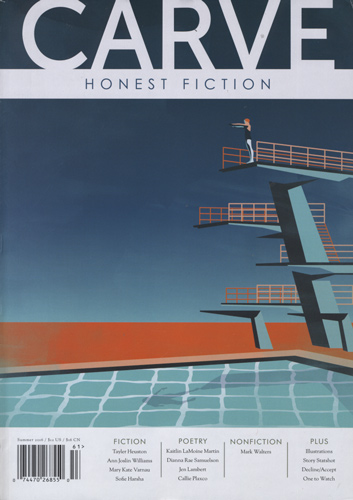Carve Magazine – Summer 2016
It’s been quite some time since I have been able to write a review for Carve—in fact the last issue I did review was Summer 2012, their final issue before moving to and including the new[ish] premium print edition—but I’ve been itching to do so for quite some time as I follow along with the places it is going. Although all stories are still available to read online for free, “because good honest fiction should never disappear into obscurity,” trust me when I say you’ll want to go ahead and purchase the premium edition.
It’s been quite some time since I have been able to write a review for Carve—in fact the last issue I did review was Summer 2012, their final issue before moving to and including the new[ish] premium print edition—but I’ve been itching to do so for quite some time as I follow along with the places it is going. Although all stories are still available to read online for free, “because good honest fiction should never disappear into obscurity,” trust me when I say you’ll want to go ahead and purchase the premium edition.
Now expanded to offer a short collection of poetry and nonfiction, Carve includes interviews with the authors of the fiction pieces about the art of writing. Another new fabulous inclusion is the section “Decline/Accept” in which the editors humbly feature a writer whose piece they rejected in the past that went on to be published elsewhere. You get to hear from the writer as well as read snippets from different versions of the text. It’s a bit of added encouragement for writers wading through rejection letters—there is hope for you yet.
Each piece of fiction also includes a “story statshot.” For example, the first piece by Taylor Heuston was first written in January 2015 with 15 drafts to follow and five rejections before it found its home at Carve. I read Heuston’s “Daughters” before dinner on vacation, and it actually became a topic of discussion around the table: how far will grief take you? Using fruit as a metaphor of how the narrator has come undone, Heuston starts, “I stood between the melons in the produce section at Lundari’s, honeydew and watermelon, thinking about the lost daughters of the world . . . And suddenly all I wanted was one soft, ripe melon. I was going to eat it in the pool.” After a surprise miscarriage (she didn’t know she was pregnant), our narrator reverts to a childlike state, and gets held up in the parking lot by a twelve-year-old girl who proceeds to steal all her money and her vehicle. Yet through this, the narrator desperately wants to care for this child as if she were the daughter she may have lost. This piece definitely lives up to Carve’s subtitle of “honest fiction” as Heuston honestly illustrates how a person can become unhinged:
Did I look deranged? Or just very sad? It’s hard to tell sometimes because the average person doesn’t really like to put their suffering out there, to perform it so plainly, so we can’t know with any certainty who is harmless and who is not. We don’t have a good baseline.
Although the storyline is somewhat wild, the characters are authentically relatable and bring the story home. If you read one from this collection, let this be it.
But of course that’s not to say there are not others here, too, worth your time. Ann Joslin Williams’s “Restoration” flips back and forth a lot between two important deaths in Kenton Pierce’s life—the death of his wife, Gem, and the death of whomever he finds buried in his woods. This, too, is a story of grief, and the details and metaphors throughout are on point:
“Funny birds, aren’t they?” she said. “That wing drumming thing they do? The first time I heard it I swore it was somebody trying to start a cranky motorcycle out in the back forty.”
“That sounds about right.” Though from his experience, the sound was more felt than heard. It was as if the vibrations—those hollow throbs—traveled the ground and entered your body, disguised as the rhythm of your own heart. Like his ear on Gem’s chest, that drum of life seemed to be both their heartbeats merged together, yet there was nothing he could do to rescue her.
And I found the interview with Williams to be of particular interest; from reading it, I’d definitely want to be a student of hers. Beyond interesting though, the interview is insightful and offers great tips to writers.
I read Callie Plaxco’s poem “Once in a Shuttle to JFK, I Overheard Two Girls on Their Way to a Funeral for a Friend’s Mother Who Died Ice Fishing” several, several times. It’s simple and short, but the imagery is fantastic. The juxtaposition of the title next to these lines is just perfect:
to pour milk into
honey-colored tea,
to watch
the milk smoke bloom
then settle.
I’ll let the rest of the issue speak for itself, because trust me, it will. Carve is definitely a must-read and must-watch magazine as it carefully treads the water between being a magazine for people who just want to read great literature and a magazine made for writers—and elegantly swims in the middle as one for both.
[www.carvezine.com]





